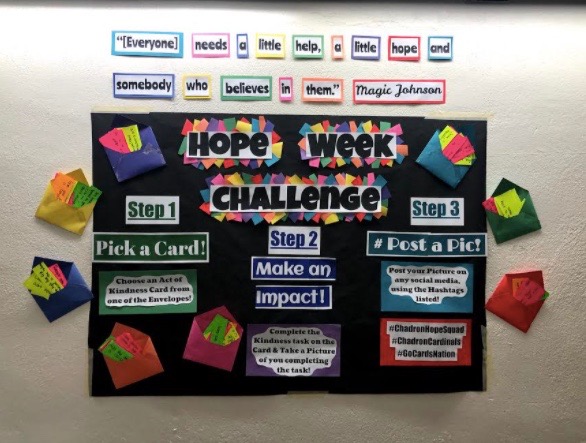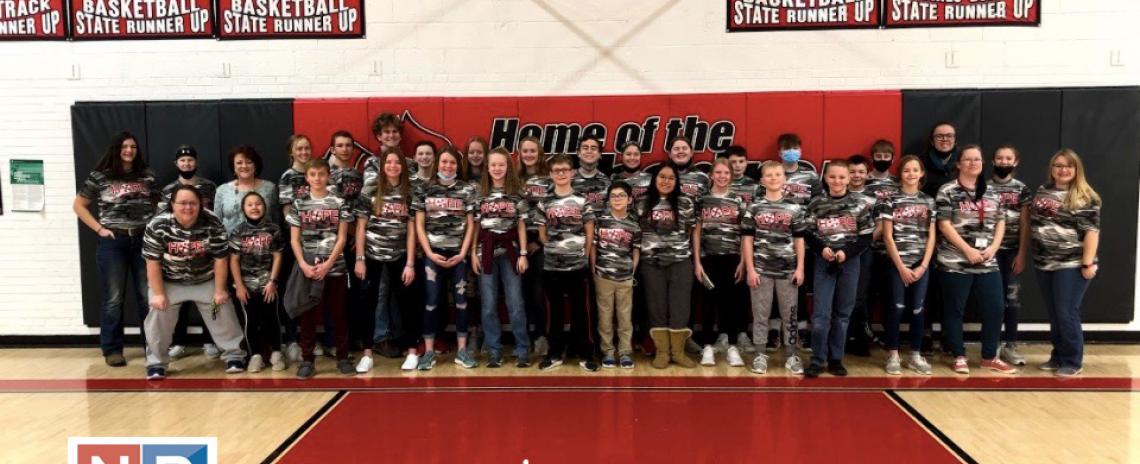The Hope Squad: Chadron Middle School's 31 Keepers of Kindness
The Hope Squad: Chadron Middle School's 31 Keepers of Kindness
By Tyler Dahlgren
Rebecca Dubs learned everything she needed to know about the character of the first-ever Chadron MIddle School Hope Squad by observing one intentionally impracticable group activity.
In their hands, 31 students heldcards containing 31 different pictures, from pieces of furniture to colors to articles of clothing. Anything and everything. Categorically, some made sense. Others came with neither rhyme nor reason.
First, the students were instructed not to reveal the content of their cards. Next, they were asked not to speak. Then they were let loose, tasked with forming groups based on the themes of their cards.
In the end, everyone found a home. Not one kid, no matter how random their card, was left on an island. It was a test, and by bending the rules in all the right ways, the Hope Squad passed with flying colors.
“They were doing everything they could to fit those kiddos that didn’t belong into a group,” said Dubs, a reading teacher at the school and one of six Hope Squad advisors. “That just showed us how amazing these kids are.”
That activity is reflective of the purpose Chadron Hope Squad serves at CMS every day. They’re silo-busters and positivity-spreaders, voted on by their peers to make the hallways of their school warm and welcoming for everyone.
“We joke and call the Hope Squad our ninjas, because they’re our eyes in the building and they’re watching out for the well-being of their peers,” said Jennifer Cattnach, lead advisor for the Hope Squad and the school’s health teacher.
Cattnach immediately jumped on board when principal Nick Dressel approached her last year about starting a Hope Squad, a peer-to-peer suicide prevention program founded in Utah. Students selected to the Hope Squad receive QPR training and learn how to have difficult but crucial conversations with peers in crisis.
The model empowers students to hold one another accountable when it comes to kindness.
“We’re placing a lot of responsibility on the kids and a lot of trust,” said Dubs. “Obviously, they’re trustworthy kids anyway. Their peers picked them because they’re the kids that can be trusted.”
Students filled out surveys at the beginning of the school year and were asked to list three classmates they’d feel comfortable coming to if they were facing a difficult situation. Those surveys were counted, tallied, and the Hope Squad was formed.
“That’s a pretty powerful thing, to be selected by your peers,” said Dressel. “We’re not pulling kids who we think are great. I think all of our kids are great, obviously, but the Hope Squad is selected by students who know them best, which is awesome.”
The Hope Squad meets every other week, and leaders touch base on the weeks between to come up with lessons and activities.
“Lessons during those meetings are centered around how to have a conversation with kids that might be having thoughts of hurting themselves,” Cattnach said. “We go along the mental health avenue as well, talking about things they can do for self-care and different ways we can build a positive atmosphere in the building.”
The program was initially formed in March, but the pandemic pushed the launch date to last September. Since then, the Hope Squad has been busy making an impact at the school. Each month, they hold different spirit-lifting activities. Before Christmas, for example, they put on a Hope Week, which sent students into break with a boost of positivity.
“There were notes of kindness left on lockers that said ‘Have a great day!’ and different things like that,” said sixth-grader Tobin Landon, a member of the Hope Squad. “Just simple messages of encouragement like that can meet a lot to somebody.”
Though they’re calling this “Year One”, the goals for the Hope Squad are lofty, and rightfully so. Cattnach said they hope it becomes a community-wide thing eventually. In addition to the six advisors, the Hope Squad works with one community partner in Western Communities Health Resources.
“Hope Squad actually has K through college-level curriculum,” Cattnach said. “You can plug Hope Squad into elementary schools, into high schools and even into colleges and communities, which is what we would like to see happen here.”
The leaders have already been fascinated by what the program has done for student leadership in the school.
“We’ve had a lot of kids really step up with keeping their eyes open,” said Cattnach. “It’s taught them responsibility in not just focusing on themselves, but those around them. It’s grown leadership in a way that I’m not sure they’re even realizing in the moment.”
Middle school is the perfect time to instill the importance of kindness in kids, said Dressel.
“I love middle school students, they’re super easy to know,” he said. “They’re so many wonderful things, but middle school kids don’t always have that filter. Things come out of their mouths that they don’t always necessarily mean. Maybe they’re angry and say the first thing that comes to their mind. Working with kids about intentionality and about how important kindness is, I think that pays dividends down the road.”
So far, the 31 members of Chadron’s Hope Squad have not only received the message, but they’ve spread it like wildfire. Dressel admits that it can be a little scary, rolling out a program such as this, especially at first. If he’s being honest, he wasn’t totally sure how it would play out.
“But kids are the eyes and ears of a school,” said Dressel. “They hear and see things way before adults do most of the time. If it means that we can use that to keep kids safe, it would be a dereliction of duty not to do something like this.”
It’s like the story Dubs shared, her favorite from a school year already filled with memorable moments.
The story about the pictures on cards and the kids who would stop at nothing to make sure no one was left out.
“Kids are capable of amazing things.”



